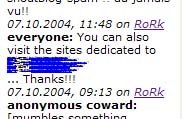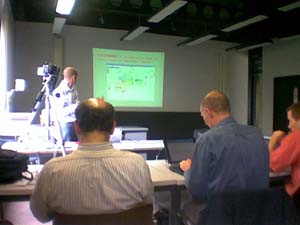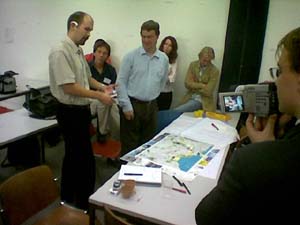Posted: October 18th, 2004 | No Comments »
Via Wired, from Deadalus, volume 133, issue 2:
“Evidence suggests that if we use an increase in our incomes, as many of us do, simply to buy bigger houses and more expensive cars, then we do not end up any happier than before. But if we use an increase in our incomes to buy more of certain inconspicuous goods – such as freedom from a long commute or a stressful job – then the evidence paints a very different picture… Reallocating our time and money in these and similar ways would result in healthier, longer – and happier – lives.“
Posted: October 11th, 2004 | Comments Off
A few minutes after the CatchBob project page had been online, it has been smartmobbed.
Posted: October 9th, 2004 | No Comments »
After more than one year of existence, the ShoutBlog unexpectedly received its first spam message. A sign of maturity?

Posted: October 9th, 2004 | Comments Off
The workshop on Spatial Awareness in Collaboration and Group Interaction was an enjoyable hands-on experience. Unfortunately my group did not want to study and setup a shoplifting collaborative system. They more wanted to stick close to the more common spatial and collaborative tasks (firefighter, rescue team).

CatchBob! presentation by Nicolas

Jari Laru funky homemade all-in-one plastiline gadget
The few thoughts and pictures of Nicolas.
Posted: October 5th, 2004 | No Comments »
After reading that west Germany financed a formula one race track in east Germany, it made me think of The Simpsons Monorail episode. As mentionned by Pascal, reality has imitated “The Simpsons” in other occasions as mentionned Fresh From ‘Simpsons,’ Tomacco Becomes a Reality. The Albuquerque Isotopes now exist, as well as Tomacco the tomato-tobacco hybrid!
Posted: October 4th, 2004 | Comments Off
The list of events I plan to take part of at the CSCL SIG First Symposium this week:
WEDNESDAY
09h30-18h – CE 1
Mosil Workshop
THURSDAY
Group participation
11h30-12h30 – CE103 (Paper Session)
U. Creâ & Hesse, F. Why group-awareness tools can undermine participation. The effect of providing participants’ portraits in a virtual informationexchange environment Tholander, J. & Fernaeus, Y. Embodied programming with visual and tangible representations.
Spatial Awareness in Collaboration and Group Interaction
14h00-18h00 – CE101 (Workshop)
The workshop about spatial positioning in mobile collaboration aims to study the relationships between space, collaborative problem solving and cognition in group. It will address basic research issues at the crossroads of human cognition and information technology. The workshop will basically be divided into two parts: paper presentation and an hands-on activity. The idea will be to form groups who will have to design a location based service intended for collaborative work/learning using low tech prototyping techniques. This will foster discussion about various question with regards to people’s research interests, collaborative scenario and features to support them.
FRIDAY
Visualizing social space
10h00-11h00 – CE100 (Paper session)
Ramberg, R. Creative Collaboration with represent-tations in an Interactive Space. Purbojo, P. & De Hoog, R. The effects of visual information on shaping communication patterns and decision processes in a collaborative and distributed computer based environment.
Interaction Analysis
14h00-18h00 – CE100 (workshop)
Up to the present, CSCL community has focused on the design, the implementation and the evaluation of collaborative learning environments, as well as on the understanding of collaborative learning processes. Actually, it is started to be acknowledged that the design of technology based learning environments must not be limited to the initial means of interaction itself, but needs to be extended to the means that analysing the very complex interactions that occur, thereby could support collaborative activities participants (students & teachers). The fulfi lment of the goal of awareness support for participants in collaborative leaning activities is pushed by the intensive interest to use collaborative systems in every day educational practice, where there is a need to (self) evaluate in an operational way, both the learning outcomes/processes and the quality of collaboration.
SATURDAY
11h30-12h30 – CE104
Overview of CSCL research in Taiwan
Posted: October 4th, 2004 | No Comments »
Safari now supports LiveConnect. The old article How Java to Javascript Communication Works in Java Plug-in explains how to make call to JavaScript within a Java applet. Java, JavaScript and Plug-in Interaction Using Client-Side LiveConnect explains the Applet to JavaScript and JavaScript to Applet communication. Old technology, same old bumpy road of browser implementation, but sometimes, LiveConnect is the only way to go.
Posted: October 3rd, 2004 | 1 Comment »
Via the Scout Report: The United Nations Human Settlements Programme published the first State of the World Cities report in 2001, and just recently released this updated version, The State of the World’s Cities: 2004/2005, which offers insight and critical analysis of the state of the world’s major urban areas and how they are changing, both for good and for ill. The various sections include such provocative topics as “Ticking Time-Bombs: Low-income settlements”, “Africa’s Secret Modernist City”, and “Crimes of the Child”.






